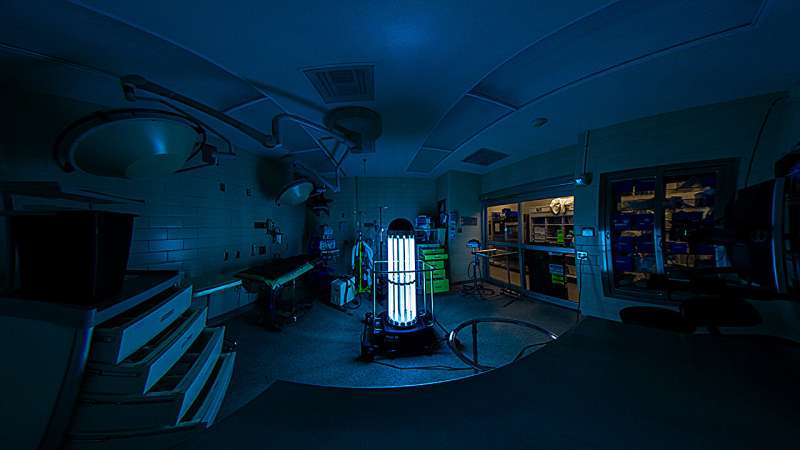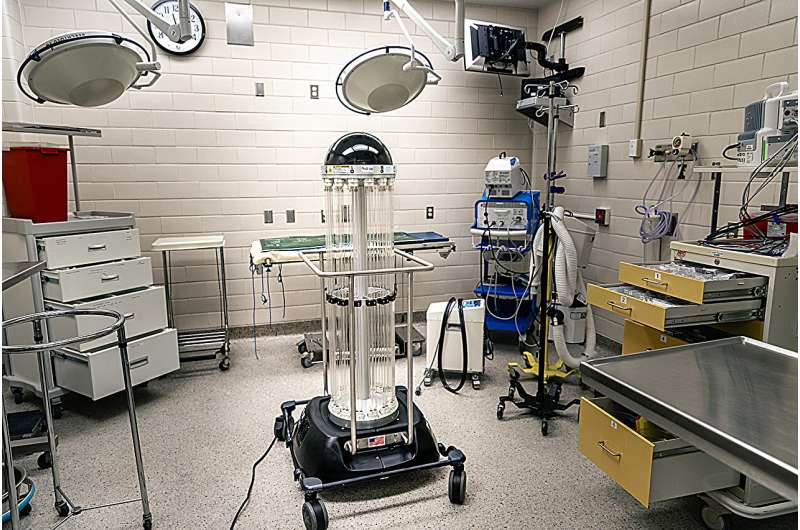This article has been reviewed according to Science X's editorial process and policies. Editors have highlighted the following attributes while ensuring the content's credibility:
fact-checked
trusted source
proofread
Disinfection robot boosts sanitation at veterinary medical teaching hospital

Robots are increasingly becoming a part of everyday life. By some estimates, over 14 million Americans own a cleaning robot, robotic lawn mower, robotic suitcase, or other similar device.
Human hospitals are also using this new technology to increase cleanliness and prevent the spread of disease.
However, a hospital robot—like the one recently acquired by the Texas A&M Veterinary Medical Teaching Hospital (VMTH)—is a little different from the Roomba that vacuums your kitchen.
The stationary robot, called Tru-D or "Trudy," uses 28 bulbs and eight ultraviolet C (UVC) centers to kill even the most resistant infection-causing bacteria that can linger on surfaces like walls, floors, and tables.
Certain bacteria, like the ones that cause staph infections, can linger in the environment for months, even after traditional cleaners have been applied to disinfect the space.
"Because some of the patients we see are very ill, with infections that can spread to other animals, and even to humans, sanitation is an important part of hospital protocols," said Pam Douglas, infection control coordinator at the VMTH.
Having seen UVC disinfection robots in action in human hospitals during her time as a registered nurse, Douglas advocated for the VMTH adding Trudy to its existing rigorous sanitation protocols.
Typical manual sanitation requires a lot of work to fulfill.
"During a manual cleaning of an operating room, we take everything out," said Katy Wendler, the assistant hospital administrator who oversees the VMTH's operating rooms. "We clean the entire base of the operating room, including the walls and ceiling, and then we clean each piece of equipment as we put it back into the room—wheels and all."
While manual cleaning is an effective way to control the spread of germs and viruses at the VMTH, it takes precious time and energy.
"It takes three operating room technicians about 30 minutes," Wendler said. "With Trudy around, our people can do other things, like spend more time with patients. We still use manual cleaning, but now we can also use Trudy to do random cleanings of rooms, even when they haven't been used recently."

How Trudy works
Although it doesn't move on its own, Trudy does look a little like a robot from science fiction. It stands several feet tall, is cylindrical in shape, and has UVC lights running vertically up and down its sides.
Once Trudy has been placed in a room, its 360-degree sensors determine how large the space is and how long the disinfection cycle should be. Most cycles for smaller rooms are about 15-20 minutes long, while larger rooms may take 30-40 minutes.
While UVC disinfection robots are common in human hospitals, veterinary hospitals rarely use this kind of technology.
"Since we got the robot at the beginning of this year, we've used it over 800 times," Douglas said. "We use it everywhere—in operating rooms, exam rooms, isolation rooms, and ICU in both the large animal and small animal teaching hospitals."
A state-of-the-art disinfection robot might sound like a complicated piece of machinery, but, thankfully, it's simple enough for anyone to run after some training.
"There are many people here who are trained to run Trudy besides the infection prevention department," Douglas said. "All of the controls are on an iPad."
Together, Trudy and the VMTH are working hard to make sure that the hospital is held to the highest standards of infection control.
"Even though we clean, Trudy is an enhancement to our patients, staff, faculty, and even the community," Douglas said. "It ensures that we protect everyone as much as possible from the environmental spread of germs."














